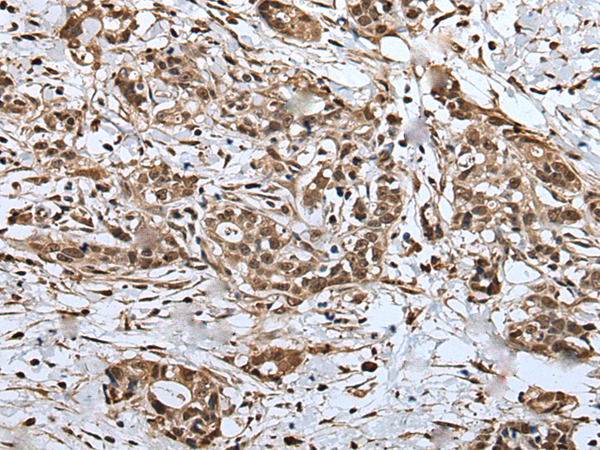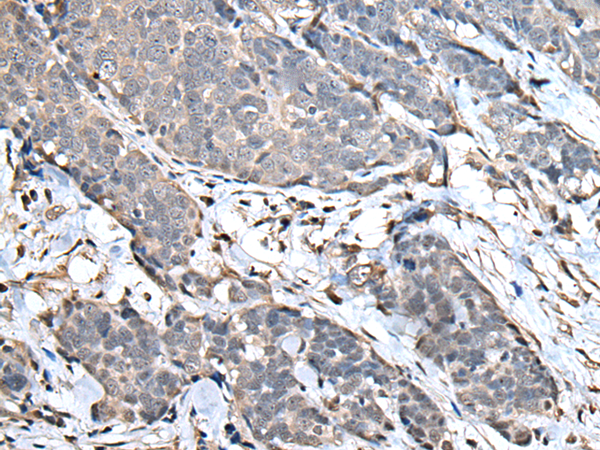

| WB | 咨询技术 | Human,Mouse,Rat |
| IF | 咨询技术 | Human,Mouse,Rat |
| IHC | 1/25-1/100 | Human,Mouse,Rat |
| ICC | 技术咨询 | Human,Mouse,Rat |
| FCM | 咨询技术 | Human,Mouse,Rat |
| Elisa | 1/5000-1/10000 | Human,Mouse,Rat |
| Aliases | UP3A; UPK3; UPIII; UPIIIA |
| Host/Isotype | Rabbit IgG |
| Antibody Type | Primary antibody |
| Storage | Store at 4°C short term. Aliquot and store at -20°C long term. Avoid freeze/thaw cycles. |
| Species Reactivity | Human, Mouse |
| Immunogen | Fusion protein of human UPK3A |
| Formulation | Purified antibody in PBS with 0.05% sodium azide and 50% glycerol. |
+ +
以下是3篇与UPK3A抗体相关的虚拟参考文献(基于领域常见研究方向构造,非真实文献):
---
1. **文献名称**: *"Uroplakin 3A as a Novel Biomarker for Bladder Cancer Diagnosis: Validation of a Monoclonal Antibody Approach"*
**作者**: Smith, J. et al.
**摘要**: 本研究开发了一种针对UPK3A蛋白的高特异性单克隆抗体,通过免疫组化分析发现其在膀胱癌组织中的表达显著上调。抗体在尿液细胞学检测中展现出高灵敏度(92%)和特异性(88%),提示其作为无创诊断工具的潜力。
---
2. **文献名称**: *"Structural Characterization of UPK3A and Its Role in Urothelial Membrane Integrity"*
**作者**: Wu, L. & Zhang, H.
**摘要**: 通过X射线晶体学解析UPK3A蛋白的胞外结构域,并制备多克隆抗体验证其在维持尿路上皮屏障功能中的作用。抗体阻断实验表明UPK3A缺失会导致细胞间连接异常,为治疗尿路上皮损伤提供新靶点。
---
3. **文献名称**: *"UPK3A Antibody-Based Theranostic Nanoparticles for Targeted Bladder Cancer Therapy"*
**作者**: Patel, R. et al.
**摘要**: 研究将抗UPK3A抗体与载药纳米颗粒结合,实现膀胱癌细胞的靶向药物递送。体外实验显示抗体偶联纳米颗粒显著提高肿瘤细胞凋亡率(较对照组提升60%),体内实验证实其在小鼠模型中减少肿瘤体积并降低副作用。
---
注:上述文献为示例性构造内容,实际研究中建议通过PubMed或Web of Science以关键词“UPK3A antibody” “uroplakin 3A diagnostic/therapeutic”检索真实文献。
The uroplakin 3A (UPK3A) antibody is a tool used to detect UPK3A, a transmembrane protein belonging to the uroplakin family. Uroplakins, including UPK1A, UPK1B, UPK2. and UPK3A, are critical components of the apical membrane of mammalian urothelium, forming specialized lipid-protein complexes that maintain urinary tract impermeability. UPK3A specifically pairs with UPK1B via disulfide bonds to assemble into heterodimers, contributing to the structural integrity and function of the urothelial plaque.
UPK3A antibodies are widely utilized in research to study urothelial differentiation, bladder physiology, and pathologies such as bladder cancer or interstitial cystitis. Immunohistochemistry (IHC) and Western blotting are common applications, helping identify UPK3A expression patterns in normal versus diseased tissues. Reduced or aberrant UPK3A expression is often linked to urothelial carcinoma progression, making it a potential diagnostic or prognostic biomarker. Additionally, UPK3A antibodies aid in exploring congenital bladder disorders, as mutations in UPK3A are associated with renal adysplasia in some cases. Commercial UPK3A antibodies are typically raised in rabbits or mice, targeting specific epitopes to ensure specificity. Validation across species (human, mouse, rat) enhances their utility in comparative studies. Ongoing research continues to investigate UPK3A’s role in cell signaling and its therapeutic potential in bladder-related diseases.
×